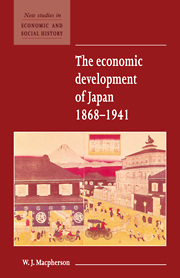Book contents
- Frontmatter
- Contents
- List of tables
- Notes on references
- Preface
- 1 Introduction
- 2 Growth and structural change
- 3 The Tokugawa background (c. 1600–1860)
- 4 The role of the state
- 5 Factors in demand
- 6 Land and agriculture
- 7 Labour supply and the labour market
- 8 Capital, technology and enterprise
- 9 Conclusion
- Bibliography
- Bibliographical update
- Updated bibliography
- Index
- New Studies in Economic and Social History
3 - The Tokugawa background (c. 1600–1860)
Published online by Cambridge University Press: 11 January 2010
- Frontmatter
- Contents
- List of tables
- Notes on references
- Preface
- 1 Introduction
- 2 Growth and structural change
- 3 The Tokugawa background (c. 1600–1860)
- 4 The role of the state
- 5 Factors in demand
- 6 Land and agriculture
- 7 Labour supply and the labour market
- 8 Capital, technology and enterprise
- 9 Conclusion
- Bibliography
- Bibliographical update
- Updated bibliography
- Index
- New Studies in Economic and Social History
Summary
The thesis of a dramatic, discontinuous transformation from feudal backwardness to twentieth-century industrialisation is no more tenable for Japan than that of an industrial revolution for Britain. The Tokugawa economy was producing a large surplus above peasant self-consumption, though much of it was ‘wasted’ in unproductive outlays. The potentiality for rapid growth existed but was constrained by the objects of the state and by its policy of seclusion. The Meiji Restoration was to reduce the remaining shackles on home and overseas markets and to permit greater freedom for individuals to respond to economic forces.
The Tokugawa era dates from the early seventeenth century. While the titular ruler of Japan remained the emperor in Kyoto, the effective rulers were the Tokugawa Shoguns at Edo (later Tokyo). The Shoguns owned about one-quarter of the agricultural land, the remainder being controlled by daimyo or lords in over 200 domains or fiefs. The Bakuhan system symbolised the relationships between the bakufu (central government) and the han, the domains of the quasi-independent lords. In principle, under the lords was a rigid fourfold Confucian-type hierarchy, shi-nō-kō-sho, of samurai, peasants, artisans and merchants, which in practice became more flexible. The samurai, numbering up to 2 millions in the nineteenth century, were feudal retainers, characterised as parasitic but from whose ranks were to spring some of the leaders of modern Japan. The farmers formed up to 80 per cent of the population and their rice taxes provided the main revenue. The artisans lived largely in the castle towns and satisfied the demand for luxury goods.
- Type
- Chapter
- Information
- The Economic Development of Japan 1868–1941 , pp. 17 - 24Publisher: Cambridge University PressPrint publication year: 1995
- 1
- Cited by



